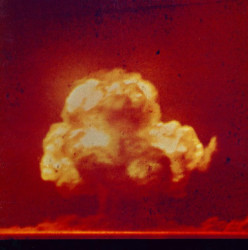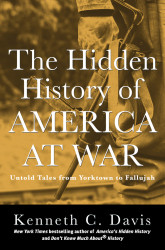A spacecraft the size of a grand piano –launched in 2006– sent back a sort of selfie from space of Pluto –from a distance of 3 billion miles.

The latest color image of Pluto shows a bright, heart-shaped terrain. NASA/Johns Hopkins Applied Physics Laboratory/Southwest Research Institute
This was an astonishing technological feat extending the human desire to know and explore to the edges of the solar system.
But this amazing evidence of humanity’s prowess to understand the universe came just days before the 70th anniversary of the birth of the Atomic Age — the successful detonation of the first atomic bomb on July 16, 1945 in a New Mexico desert at a test site called “Trinity.”

The Trinity Test The photo is courtesy Los Alamos National Laboratories; it is reproduced on the front cover of Los Alamos: Beginning of an Era, 1943-1945 (Los Alamos: Public Relations Office, Los Alamos Scientific Laboratory, ca. 1967-1971).
General Leslie Groves, the military leader of the Manhattan Project –the secret wartime American effort to develop an atomic bomb– wrote a memo describing the test that changed history:
For a brief period there was a lighting effect within a radius of 20 miles equal to several suns in midday; a huge ball of fire was formed which lasted for several seconds. This ball mushroomed and rose to a height of over ten thousand feet before it dimmed. The light from the explosion was seen clearly at Albuquerque, Santa Fe, Silver City, El Paso and other points generally to about 180 miles away. The sound was heard to the same distance in a few instances but generally to about 100 miles.
Groves cited in his memo the words of another general who commented that day:
It was a great new force to be used for good or for evil.
Source: “Memorandum for the Secretary of War” (July 18, 1945) PBS/American Experience: “Truman“
A few days later, President Truman made the fateful decision to drop two atomic bombs on Japan, hoping to force the Japanese to surrender and end the war in the Pacific. That decision, which surely shortened the war, cost hundreds of thousands of Japanese lives and opened the age of atomic warfare capable of destroying humanity. Future posts will discuss Hiroshima and Nagasaki.
The U.S. Department of Energy offers an interactive history of the Manhattan Project, the Trinity Test and the dropping the bombs.
You can read more about dropping of the atomic bombs and the Cold War atomic race in Don’t Know Much About History and The Hidden History of America at War.

Don’t Know Much About® History: Anniversary Edition (Harper Perennial and Random House Audio)

The Hidden History of America At War (Hachette Books Random House Audio)